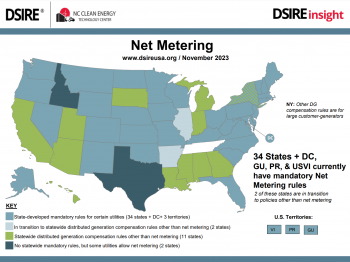What Is Net Metering?
Net metering is a billing mechanism that credits solar energy system owners for the electricity they add to the grid. For example, if a residential customer has a PV system on their roof, it may generate more electricity than the home uses during daylight hours. If the home is net-metered, the electricity meter will run backward to provide a credit against what electricity is consumed at night or other periods when the home’s electricity use exceeds the system’s output. Customers are only billed for their “net” energy use. On average, only 20-40% of a solar energy system’s output ever goes into the grid, and this exported solar electricity serves nearby customers’ loads.
Giving Customers Control Over Their Electricity Bills
Net metering allows utility customers to generate their own electricity cleanly and efficiently. During the day, most solar customers produce more electricity than they consume; net metering allows them to export that power to the grid and reduce their future electric bills.
Creating Jobs & Encouraging Private Investment
Net metering provides substantial economic benefits in terms of jobs, income and investment. Net metering increases demand for solar energy, which in turn creates jobs for the installers, electricians, and manufacturers who work in the solar supply chain. Today, the solar industry employs more than 230,000 American workers in large part due to strong state net metering policies which have allowed the solar industry to thrive.
Protecting the Electric Grid
Unfortunately, some utilities perceive net metering policies as lost revenue opportunities. In fact, net metering policies create a smoother demand curve for electricity and allow utilities to better manage their peak electricity loads. By encouraging generation near the point of consumption, net metering also reduces the strain on distribution systems and prevents losses in long-distance electricity transmission and distribution. There are a wide variety of cost-benefit studies around the country that demonstrate the value solar provides to local economies and the electricity system as a whole.
Want to learn more about how net metering policies work with solar? Learn more about net metering and other solar topics on EnergySage.
Click on the map below to visit the Database of State Incentives for Renewable Energy (DSIRE), which catalogs various policies for renewable energy nationwide, including net metering. 34 states plus Washington, D.C. and Puerto Rico have mandatory net metering rules in place.

Solar Access Rights
Local ordinances or homeowner’s association (HOA) rules can affect the installation of solar systems on homes or businesses. While these rules are often created to ensure uniformity or uphold a community’s aesthetic standard, they may inadvertantly prohibit the installation of solar electric or solar heating & cooling technologies. In lieu of outright prohibition, some rules allow third parties to require that solar customers make modifications to their system design which may unreasonably increase costs, decrease efficiency, or both.
Across the country lawmakers are now acting to protect property-owners’ solar access rights. Solar easements allow a property owner to negotiate for the rights to unobstructed sunlight on their property. Solar access laws provide more protection to solar customers by prohibiting or limiting private restrictions on solar energy installations.
SEIA supports strong protection for solar access rights in order to reduce restrictions on the installation of solar technologies nationwide.
For more information, visit the Database of State Incentives for Renewables and Efficiency (DSIRE).



